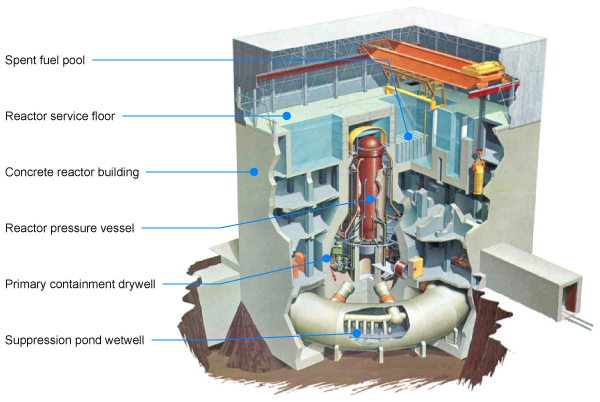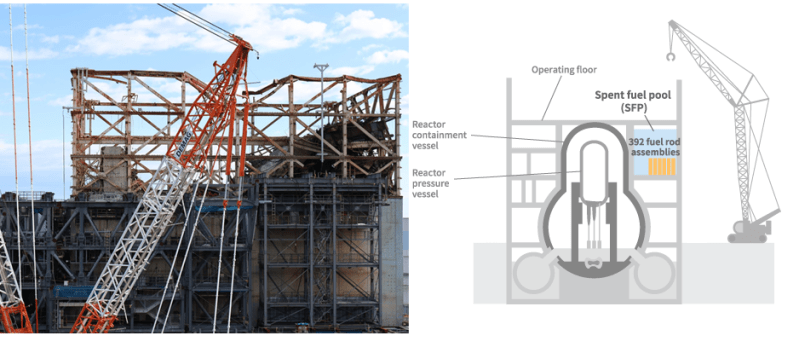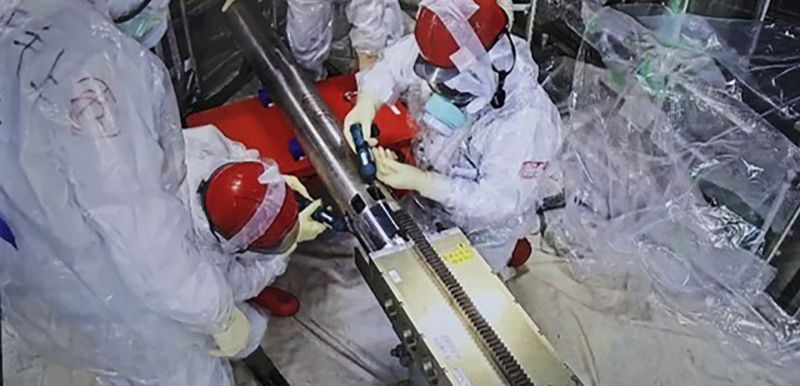On 11 March, 2011, a massive magnitude 9.1 earthquake shook the west coast of Japan, with the epicenter located at a shallow depth of 32 km, a mere 72 km off the coast of Oshika Peninsula, of the Touhoku region. Following this earthquake, an equally massive tsunami made its way towards Japan’s eastern shores, flooding many kilometers inland. Over 20,000 people were killed by the tsunami and earthquake, thousands of whom were dragged into the ocean when the tsunami retreated. This Touhoku earthquake was the most devastating in Japan’s history, both in human and economic cost, but also in the effect it had on one of Japan’s nuclear power plants: the six-unit Fukushima Daiichi plant.
In the subsequent Investigation Commission report by the Japanese Diet, a lack of safety culture at the plant’s owner (TEPCO) was noted, along with significant corruption and poor emergency preparation, all of which resulted in the preventable meltdown of three of the plant’s reactors and a botched evacuation. Although afterwards TEPCO was nationalized, and a new nuclear regulatory body established, this still left Japan with the daunting task of cleaning up the damaged Fukushima Daiichi nuclear plant.
Removal of the damaged fuel rods is the biggest priority, as this will take care of the main radiation hazard. This year TEPCO has begun work on removing the damaged fuel inside the cores, the outcome of which will set the pace for the rest of the clean-up.
Safety Cheese Holes

The Fukushima Daiichi nuclear power plant was built between 1967 and 1979, with the first unit coming online in 1970 and the third unit by 1975. It features three generations of General Electric-designed boiling water reactors of a 1960s (Generation II) design. It features what is known as a Mark I containment structure. At the time of the earthquake only units 1, 2 and 3 were active, with the quake triggering safeties which shut down these reactors as designed. The quake itself did not cause significant damage to the reactors, but three TEPCO employees at the Fukushima Daiichi and Daini plants died as a result of the earthquake.
A mere 41 minutes later the first tsunami hit, followed by a second tsunami 8 minutes later, leading to the events of the Fukushima Daiichi accident. The too low seawall did not contain the tsunami, allowing water to submerge the land behind it. This damaged the seawater pumps for the main and auxiliary condenser circuits, while also flooding the turbine hall basements containing the emergency diesel generators and electrical switching gear. The backup batteries for units 1 and 2 also got taken out in the flooding, disabling instrumentation, control and lighting.
One hour after the emergency shutdown of units 1 through 3, they were still producing about 1.5% of their nominal thermal power. With no way to shed the heat externally, the hot steam, and eventually hydrogen from hot steam interacting with the zirconium-alloy fuel rod cladding, was diverted into the dry primary containment and then the wetwell, with the Emergency Core Cooling System (ECCS) injecting replacement water. This kept the cores mostly intact over the course of three days, with seawater eventually injected externally, though the fuel rods would eventually melt due to dropping core water levels, before solidifying inside the reactor pressure vessel (RPV) as well as on the concrete below it.
It was attempted to vent the steam pressure in unit 1, but this resulted in the hydrogen-rich air to flow into the service floor, where it found an ignition source and blew off the roof. To prevent this with unit 2, a blow-out panel was opened, but unit 3 suffered a similar hydrogen explosion on the service floor, with part of the hydrogen also making it into the defueled unit 4 via ducts and similarly blowing off its roof.
The hydrogen issue was later resolved by injecting nitrogen into the RPVs of units 1 through 3, along with external cooling and power being supplied to the reactors. This stabilized the three crippled reactors to the point where clean-up could be considered after the decay of the short-lived isotopes present in the released air. These isotopes consisted of mostly iodine-131, with a half-life of 8 days, but also cesium-137, with a half-life of 30 years, and a number of other isotopes.
Nuclear Pick-up Sticks
Before the hydrogen explosions ripped out the service floors and the building roofs, the clean-up would probably have been significantly easier. Now it seemed that the first tasks would consist out of service floor clean-up of tangled metal and creating temporary roofs to keep the elements out and any radioactive particles inside. These roof covers are fitted with cameras as well as radiation and hydrogen sensors. They also provide the means for a crane to remove fuel rods from the spent fuel pools at the top of the reactors, as most of the original cranes were destroyed in the hydrogen explosions.

This meant that the next task is to remove all spent fuel from these spent fuel pools, with the status being tracked on the TEPCO status page. As units 5 and 6 were undamaged, they are not part of these clean-up efforts and will be retained after clean-up and decommissioning of units 1-4 for training purposes.
Meanwhile, spent fuel rods were removed already from units 3 and 4. For unit 1, a cover still has to be constructed as has has been done for unit 3, while for the more intact unit 2 a fuel handling facility is being constructed on the side of the building. Currently a lot of the hang-up with unit 1 is the removal of debris on the service floor, without risking disturbing the debris too much, like a gigantic game of pick-up sticks. Within a few years, these last spent fuel rods can then be safely transported off-site for storage, reprocessing and the manufacturing of fresh reactor fuel. That’s projected to be 2026 for Unit 2 and 2028 for Unit 1.
This spent fuel removal stage will be followed by removing the remnants of the fuel rods from inside the RPVs, which is the trickiest part as the normal way to defuel these three boiling-water reactors was rendered impossible due to the hydrogen explosions and the melting of fuel rods into puddles of corium mostly outside of the RPVs. The mostly intact unit number 2 is the first target of this stage of the clean-up.

To develop an appropriate approach, TEPCO relies heavily on exploration using robotic systems. These can explore the insides of the units, even in areas which are deemed unsafe for humans and can be made to fit into narrow tubes and vents to explore even the insides of the RPVs. This is how we have some idea of where the corium ended up, allowing for a plan to be formed for the extracting of this corium for disposal.
Detailed updates on the progress of the clean-up can be found as monthly reports, which also provide updates on any changes noted inside the damaged units. Currently the cores are completely stable, but there is the ongoing issue of ground- and rainwater making it into the buildings, which causes radioactive particles to be carried along into the soil. This is why groundwater at the site has been for years now been pumped up and treated with the ALPS radioactive isotope removal system. This leaves just water with some tritium, which after mixing with seawater is released into the ocean. The effective tritium release this way is lower than when the Fukushima Daiichi plant was operating.

In these reports we also get updates on the robotic exploration, but the most recent update here involves a telescoping robot nicknamed ‘Telesco’ (because it can extend by 22 meters) which is tasked with retrieving a corium sample of a few grams from the unit 2 reactor, in the area underneath the RPV where significant amounts of corium have collected. This can then be analyzed and any findings factored into the next steps, which would involve removing the tons of corium. This debris consists of the ceramic uranium fuel, the zirconium-alloy cladding, the RPV steel and the transuranics and minor actinides like plutonium, Cs-137 and Sr-90, making it radiologically quite ‘hot’.
Looking Ahead
Although the clean-up of Fukushima Daiichi may seem slow, with a projected completion date decades from now, the fact of the matter is that time is in our favor, as the issue of radiological contamination lessens with every passing day. Although the groundwater contamination is probably the issue that gets the most attention, courtesy of the highly visible storage tanks, this is now fully contained including with sea walls, and there is even an argument to be made that dilution of radioisotopes into the ocean would make it a non-issue.
Regardless of the current debate about radiological overreacting and safe background levels, most of the exclusion zone around the Fukushima Daiichi plant has already been reopened, with only some zones still marked as ‘problematic’, despite having background radiation levels that are no higher than the natural levels in other inhabited regions of the world. This is also the finding of the UNSCEAR in their 2020 status report (PDF), which finds levels of Cs-137 in marine foods having dropped already sharply by 2015, no radiation-related events in those evacuated or workers in the exclusion zone, and no observed effects on the local fauna and flora.
Along with the rather extreme top soil remediation measures that continue in the exclusion zone, it seems likely that within a few years this exclusion zone will be mostly lifted, and the stricken plant itself devoid of spent fuel rods, even as the gradual removal of the corium will have begun. First starting with small samples, then larger pieces, until all that will left inside units 1-3 will be some radioactive dust, clearing the way to demolish the buildings. But it’s a long road.
